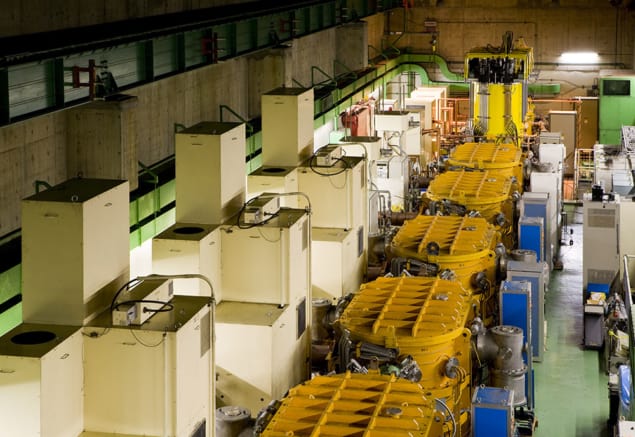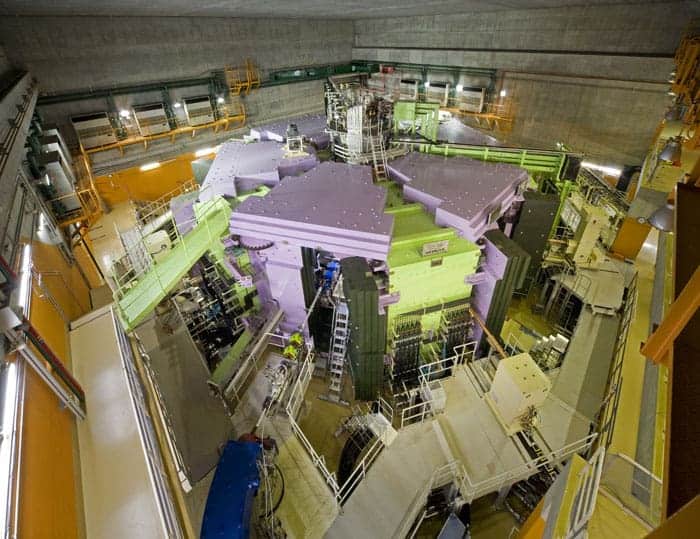
Scientists in Japan have become the first to observe the super-heavy oxygen isotopes oxygen-27 (27O) and oxygen-28 (28O). The latter packs a whopping 20 neutrons into its nucleus alongside its eight protons and was a candidate for “double magic” status, meaning it was thought to be especially stable. However, a team at the Tokyo Institute of Technology and RIKEN found that this was not the case. The discovery should help us improve upon current theories of nuclear structure and could have implications for the physics of neutron stars.
When nuclear physicists talk about magic numbers, they aren’t discussing digits that exist in a realm of wizards and warlocks. What they’re referring to is a situation in which an atom’s nucleons (protons and neutrons) are arranged in such a way as to make its nucleus unusually stable. Specifically, atoms with 2, 8, 20, 28, 50, 82 or 126 protons or neutrons are highly unlikely to undergo energy losses due to radioactive decay.
Takashi Nakamura, a physicist at the Tokyo Institute of Technology and one of the authors of a paper in Nature on the discovery, explains the magic-number concept using the nuclear shell model. “You can consider a nucleus made of a number of multi-layered shells,” he says. “You can imagine this like an onion. Each shell has a definite number of ‘seats’. If the seats in one shell are filled with neutrons (or protons), then the shell is ‘closed’.”
A source of stability
Nakamura gives the example of 16O, which has eight neutrons and eight protons. Two neutrons fill its first shell, and the next six neutrons fill the second shell. The shells for protons and neutrons act independently of each other, so the same stacking procedure within shells also works for the protons in 16O.
When both neutrons and protons are magic numbers, as in 16O, the nucleus is termed “doubly magic”. This situation is extremely rare. Among naturally occurring nuclei, we know of only four others besides 16O that meet the criteria: helium-4, calcium-40, calcium-48 and lead-208.
In exotic nuclei, which are either artificially generated or exist for only very short times, the list is similarly short, with only seven candidates for double magic status. The 28O isotope of oxygen was the last candidate to be tested.
Four-neutron measurement
To find out if 28O is doubly magic, Nakamura and his team first had to create it. For this, they worked with researchers at the RIKEN Radioactive Isotope Beam Factory in Wako, on the outskirts of Tokyo. The researchers accelerated a beam of calcium-48 (48Ca) atoms to 70% the speed of light and directed it at a thick target made of beryllium. The beryllium nuclei act like tiny knives, stripping protons and neutrons from 48Ca to turn it into fluorine-29 (29F). In the final step, the 29F, which is still moving at 60% of the speed of light, impinges on a proton. The resulting collision removes a proton from the nucleus, leaving 28O.
Detecting the newly created 28O and 27O was an achievement, Nakamura says, because it involved observing them via their decay into 24O and four or three neutrons, respectively. “Neutron detection is very difficult at this energy,” he explains. “Before this publication, up to two-neutron measurement has been a limit. I know of one exceptional example of the three-neutron measurement. But I’ve never seen the four-neutron measurement in coincidence.”
No magic here
The team had good theoretical reasons to expect 28O to be doubly magic. “For 28O, it has eight protons and 20 neutrons,” Nakamura explains. “The 20 neutrons have three shells: the first shell has two seats, the second shell has six seats, and the third shell has 12 seats. With that the shells are closed with 20 neutrons.”
This, however, was not what the researchers observed. Though the proton seats were filled, as expected, the energy gap between the final two neutron shell orbitals was weak, allowing mixing between these two shells. “This kind of shell erosion sometimes happens for neutron-rich nuclei, but it was not at all obvious for 28O as the protons still fill the normal seats of eight,” Nakamura says.

Why 34 is the magic number for calcium
Discovering that 28O lacks the doubly-magic touch is not a failure, though. In fact, Nakamura describes it as “an important benchmark” in modern nuclear theory. He adds that the result should make it possible to improve our theories about isotopes with large neutron/proton ratios. The research can also help us assess unknown nuclear interactions such as three-neutron forces, which are important for evaluating the properties of neutron stars.
- SEO Powered Content & PR Distribution. Get Amplified Today.
- PlatoData.Network Vertical Generative Ai. Empower Yourself. Access Here.
- PlatoAiStream. Web3 Intelligence. Knowledge Amplified. Access Here.
- PlatoESG. Automotive / EVs, Carbon, CleanTech, Energy, Environment, Solar, Waste Management. Access Here.
- PlatoHealth. Biotech and Clinical Trials Intelligence. Access Here.
- ChartPrime. Elevate your Trading Game with ChartPrime. Access Here.
- BlockOffsets. Modernizing Environmental Offset Ownership. Access Here.
- Source: https://physicsworld.com/a/newly-observed-oxygen-28-nucleus-fails-double-magic-test/
- :has
- :is
- :not
- :where
- $UP
- 12
- 20
- 28
- 50
- 8
- a
- About
- AC
- accelerated
- achievement
- Act
- Adds
- All
- Allowing
- alongside
- also
- among
- an
- and
- ARE
- arranged
- AS
- assess
- At
- authors
- BE
- Beam
- because
- become
- been
- besides
- between
- both
- but
- CAN
- candidate
- candidates
- case
- closed
- coincidence
- collision
- concept
- Consider
- could
- create
- created
- criteria
- Current
- Detection
- difficult
- digits
- directed
- discovered
- discovery
- discussing
- double
- doubly
- due
- each
- either
- energy
- especially
- evaluating
- example
- exceptional
- exist
- Exotic
- expect
- expected
- Explains
- extremely
- fact
- factory
- fails
- Failure
- fill
- filled
- final
- Find
- First
- For
- Forces
- found
- four
- from
- gap
- generated
- gives
- good
- had
- happens
- Have
- he
- help
- highly
- his
- However
- http
- HTTPS
- i
- if
- image
- imagine
- implications
- important
- improve
- in
- independently
- information
- Institute
- interactions
- into
- involved
- issue
- IT
- ITS
- Japan
- jpg
- Kind
- Know
- large
- Last
- leaving
- light
- like
- LIMIT
- List
- losses
- made
- magic
- make
- max-width
- meaning
- measurement
- Meet
- Mixing
- Modern
- moving
- multi-layered
- Nature
- Neutron stars
- neutrons
- never
- newly
- next
- normal
- nuclear
- number
- numbers
- observe
- obvious
- occurring
- of
- on
- ONE
- only
- or
- Other
- Others
- our
- out
- Oxygen
- Packs
- Paper
- photo
- Physics
- Physics World
- plato
- Plato Data Intelligence
- PlatoData
- possible
- procedure
- properties
- protons
- provided
- Publication
- RARE
- realm
- reasons
- research
- researchers
- respectively
- result
- resulting
- RIKEN
- same
- says
- Second
- seen
- seven
- Shell
- Short
- should
- Similarly
- situation
- SIX
- So
- Source
- specifically
- speed
- stable
- stacking
- Stars
- Status
- Step
- Still
- stripping
- structure
- such
- Talk
- Target
- team
- Technology
- test
- tested
- that
- The
- their
- Them
- then
- theoretical
- theory
- These
- they
- Third
- this
- though?
- thought
- three
- thumbnail
- times
- to
- tokyo
- touch
- true
- TURN
- two
- undergo
- unknown
- unlikely
- upon
- us
- used
- using
- very
- via
- was
- Way..
- we
- were
- What
- which
- Wikipedia
- with
- within
- worked
- works
- world
- zephyrnet













